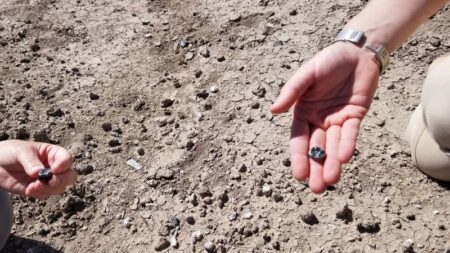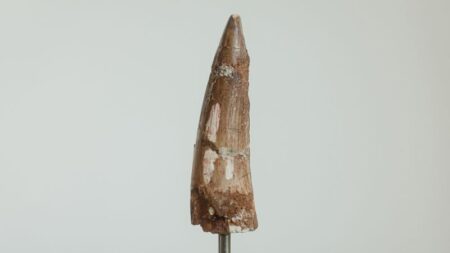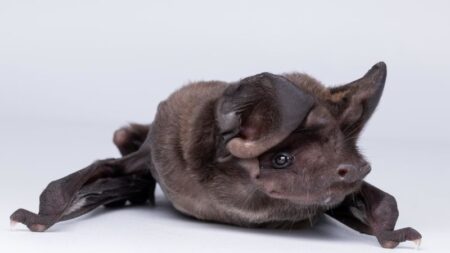An extraordinary find has surfaced from the depths of history, revealing a glob of amber that is 99 million years old. Inside this ancient resin, remarkably preserved, lies an insect—the remains of a fly that seems to exhibit an unsettling story. This fly is not just any fossil; it features what can only be described as a horror story encased in amber, with the prominent growth of what appears to be a mushroom-like fruiting body of a zombie fungus protruding from its head. This discovery paints an unsettling picture of nature’s ruthless cycle of life and death.
In tandem with the fly, a second specimen—a young ant—was found to be infected by a similar fungal organism. These remarkable finds represent two of the earliest records of a unique and intricate natural phenomenon, where parasitic fungi commandeer their hosts before ultimately leading them to their demise. This parasitic relationship takes on a new level of complexity as fungal parasites take over the bodies of insects, displaying the often brutal truths of ecological dynamics.
Yuhui Zhuang, a doctoral student at the Yunnan University’s Institute of Paleontology and the lead author of a study published in the renowned journal *Proceedings of the Royal Society B: Biological Sciences*, expressed the importance of such finds: “Amber gives us this opportunity to visualize the ancient ecological relationships preserved in fossils.” Zhuang explains that these two fossilized specimens are extraordinarily rare, boasting a unique preservation of the symbiotic relationship between fungi and insects. Indeed, amongst the tens of thousands of amber specimens explored by paleontologists, only a handful have managed to capture such intricate ecological details.
Through meticulous research employing optical microscopes and micro-computed tomography, Zhuang and colleagues identified two previously unknown species of ancient fungi belonging to the genus Ophiocordyceps. They designated these species as *Paleoophiocordyceps gerontoformicae* and *Paleoophiocordyceps ironomyiae*, found on the ant and the fly respectively. The Ophiocordyceps genus is notorious in the modern world for their ability to manipulate the behavior of their hosts—commonly known today as “zombie-ant fungi.” Interestingly, the behavior manipulation exhibited by these fungi inspired the concept behind the acclaimed video game and subsequent HBO series, *The Last of Us*, highlighting a continuation of this parasite-host dynamic through the ages.
In a deeper analysis, Zhuang speculated that these ancient fungi could have already been playing a predatory role in the ecological system of the Cretaceous period and hinted at a complex interrelationship among the organisms of that time. This discovery, according to Zhuang, hints towards the sophistication of terrestrial ecosystems millions of years ago, suggesting fungi like Ophiocordyceps began evolving as insect predators.
Transitioning to the contemporary era, the Natural History Museum in London recognizes the role of parasitic fungi, or entomopathogenic fungi, in infecting a vast range of insect species today, which includes ants, flies, spiders, cicadas, and beetles. Modern examples of Ophiocordyceps fungi infect carpenter ants by infiltrating the brain through weak spots in the insect’s exoskeleton. Such findings imply that ancient fungi likely employed similar fatal strategies in achieving their life cycle.
Meanwhile, João Araújo, a co-author and mycology curator at the Danish Natural History Museum, provided poignant insights into the broader implications of these studies. He noted that the species of fungus that infected the ant may represent a precursor to the more contemporary zombie-ant fungi, suggesting a long evolutionary journey for these parasites. He speculated that the two insects may have died from the fungi’s effects prior to being trapped in the sticky tree resin that solidified into amber, an understanding that adds context to the fossilization process.
Nevertheless, despite these intriguing findings, the fossilized diversity of parasites is a mere fraction of what once existed, underscoring a significant gap in our understanding of ancient ecosystems. Phil Barden, an associate professor at New Jersey Institute of Technology, emphasized how amber captures only a limited overview of past biodiversity, as countless hidden interactions with parasites had shaped the evolution of these ancient insects.
Amidst these revelations, co-author Edmund Jarzembowski from London’s Natural History Museum expressed his fascination regarding the continuity of strangeness in nature, emphasizing that some bizarre aspects of nature evident today existed even during the age of dinosaurs. However, it is vital to consider the ethical implications surrounding the amber sourced from Myanmar, a region fraught with conflict. While it has provided crucial insights into paleontology, researchers like Zhuang clarified that the fossils used in their study were acquired prior to 2017, aiming to satisfy ethical concerns surrounding provenance and conflict.
Each of these discoveries not only reveals the complexities of ancient ecological relationships but also illuminates a broader understanding of biodiversity through the ages, encouraging us to explore the delicate balance of life persisting within our planet’s vast history.












